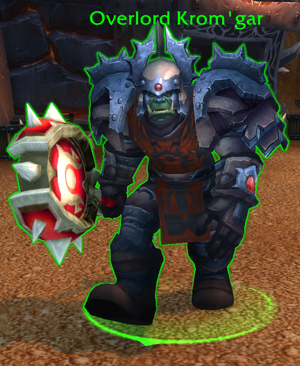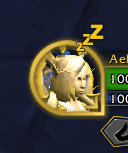Newbie guide/Chat and interface
Communication
Chat channels
- Main article: Chat
World of Warcraft has a chat channel system to allow players to create their own private chat channels. Use the /chat command to get a listing of chat channel commands. You will automatically join chat channels "General", "Trade", "Trade (Services)" and "LocalDefense" when you create your character.
To send a message to a chat channel, type "/# (message)" where # is the number of the channel you would like to send to. 1 is always the "General" channel, and 2 is the Trade channel when in a city. (Type /chatlist to see a list of channels you are currently on.)
Links to an item, outfit, or mount can be sent by shift-clicking them in their respective interface.
Pressing ⎋ Esc to open the options menu, then selecting "Edit Mode" will allow you to customize the chat box alongside other parts of the User Interface.
Mail system
- Main article: Mail
 in range to check mailbox
in range to check mailbox  out of range of mailbox
out of range of mailbox
For a small price (30![]() ), you can send in-game mail to other players. This can be sent when other players are offline or online. An icon will appear near your minimap indicating if you have new Unread Mail. To read your mail, visit a mailbox outside any inn. You can also send items through mail to other players as "attachments". Sending mail to others is instantaneous, unless there is an item attached, in which case the message will take one hour to be delivered. Attachments are returned to the sender if the message goes unread for 30 days, or if the recipient does not remove the item from their mailbox within 30 days of reading the message.[1]
), you can send in-game mail to other players. This can be sent when other players are offline or online. An icon will appear near your minimap indicating if you have new Unread Mail. To read your mail, visit a mailbox outside any inn. You can also send items through mail to other players as "attachments". Sending mail to others is instantaneous, unless there is an item attached, in which case the message will take one hour to be delivered. Attachments are returned to the sender if the message goes unread for 30 days, or if the recipient does not remove the item from their mailbox within 30 days of reading the message.[1]
You can also use a Cash on Delivery, or C.O.D, to send mail with items attached. This allows you to set a price for the recipient to be able to collect the item from the mail (i.e. you can charge them for the item). When the recipient clicks the item to put it in their pack, a dialog comes up stating the price. If they say accept, then the price is deducted from their money and sent to you in a mail message. They may also select return which will return the item to you via mail. C.O.D. items expire from the recipient's inbox in 30 days even if unread, so be sure they know that it is coming.
You may also send cash in mail, but all mail sent with money arrives with an hour delay.[2]
Mail can be sent between characters on the same account, which arrives instantly.
Resting
While in an inn or a major city (such as Valdrakken), your player portrait will begin to glow and display "ZZZ", indicating that you are resting. If you log out here, your character will continue to rest while offline. When rested, your XP bar will turn blue, and a notch will appear indicating exactly how rested you are. You will earn double XP from killing monsters while rested until your XP bar fills to the notch.
Experience you gain from a quest has no effect on the amount of rest you have left over, and it will not double up if you are rested.
One bubble of rested XP is earned for every 8 hours spent resting, up to a maximum of one-and-a-half full levels. In other words, you can leave your character resting in an inn for up to ten days without playing before you earn the maximum amount of rest state.
While not a huge amount of experience, it worth logging out in an inn if possible (remember your ![]() [Hearthstone] will teleport you there). By resting, you also receive a greater benefit from the heirloom set bonuses.
[Hearthstone] will teleport you there). By resting, you also receive a greater benefit from the heirloom set bonuses.
Friendly and hostile NPCs

Not every creature in the World of Warcraft universe is friendly, and new areas of the world are more intimidating when you can't tell who is friend or foe. Learn to spot the intent of the NPC from a distance by looking at color of their name to keep yourself from getting in over your head. A selected target will also have a circle underneath
- Friendly NPCs will have green names. This means you can't accidentally attack them, and can likely talk or trade with them.
- Neutral mobs and NPCs will have yellow names.
- Neutral mobs will not attack you unless you attack them first, at which point they will become hostile. They will revert to neutral if you go out of their attack range for long enough.
- Neutral NPCs--like friendly NPCs--typically cannot be attacked. However, there are situations in which neutral NPCs can become hostile. For example, in a neutral city like Gadgetzan, if a player starts attacking another player, the city guards that are typically neutral will become hostile and attempt to settle the matter.
- Unfriendly NPCs have orange names and are similar to Neutral NPCs, except that you initially cannot trade or talk with them. These NPCs are typically members of a faction, and if you do quests for them, or kill their enemies, you'll earn reputation with their faction. Earn a high enough reputation and their faction will usually open up new quests and items for you.
- Hostile mobs and NPCs will have red names. These will attack you once you once you enter their aggro radius. It's important to remember that an enemy's aggro range is usually relative to the difference between their level and yours. If you're at a significantly higher level, the mob will pretty much ignore you entirely.
Player characters of the same faction as you and their pets will generally have blue names. You may see that other players have red, yellow, or green names. For these conditions, see PvP flag.

